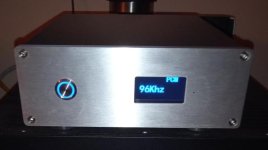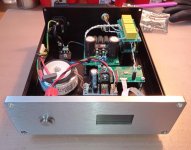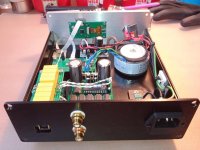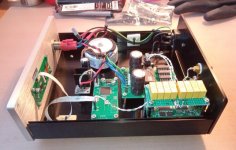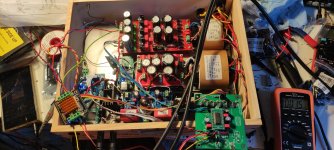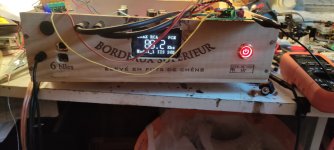Thanks dear miro@mehdism IC1 must be 74HCT164, you have only HC version ... it would be good if also other shift registers are HCT version 🙂
But the problem can be also in TDA1541, not all are good, some can have defects because all were used previously 🙂
Regarding DC offset, please note that the USB cable from USB-I2S device must be connected in computer during all testing and set-up. When the computer is off there can be always some dc offset on the output 😊
I had not paid attention to the shift registers.
In the next step , i test cpld
I put the 47NF polyester cap(Because I had less capacity ) on c15 and pink noise remove 🤷🏼 and dac work fine 😁
Thanks @miro1360 from what I understand is that this module uses SAA7220 and a Xilinx (CPLD), the ad claims that it could take I2S input and perform the job of glue logic and post xilinx it could be connected to TDA1541 or TDA1540 (14 bit-16 bit configured through a jumper), it is configurable to 4x-8x Os or NOS, MCLK could be configured for 256fs or 512fs.I never tried it, so it is impossible to say something about it 🙂
I have ordered one, since I am building my third TDA1541 DAC these days so instead of logic gates will give this module a try.
BTW: my opinion with AD1865 is that it is a highly underrated DAC (particularly the NK version) the more I use it the more I am getting convinced with it, particularly with a Burson V6, it sound much smoother and the burson gets independent supply of +/-12 volts.
Has anyone given Burson V7 vivid or classic a try?
Yes , in this thread too... Some comments by arteom ( most recent), sorenm and Brijac.Has anyone given Burson V7 vivid or classic a try?
The same thing, just packed in a metal box from Aliexpress. I put a slightly bigger and more beautiful display. I am very pleased with the sound and appearance.While I was watching the Australian Open with one eye, I built a small DAC with AD1865 N-K with another one. It's not exactly a Miro DAC, it's a Pavouk DAC, but the schematic is similar.
It has only a USB input, I took a Chinese Amanero USB/I2S card with SITIME oscillators, upgraded version. Works flawlessly with original Amanero WIN10 drivers.
The transformer is custom made 10VA. It has a grounded static shield between the primary and secondary windings and magnetic shielding. Transformer secondaries have snubbers determined by the Quasimodo tester. There is not a trace of hum even if the transformer is very close to PCBs.
It also has a small Chinese display for sampling rate. It says Welcome when it turns on. 🤣
Attachments
Yes, it's a little nicer. But it sounds the same as the plastic one. 🤣
What look like transistors are LP2950ACZ-5.0 voltage regulators. The circuit is the same as the Miro AD1865 with shift registers, only the internal opamps in the AD1865 are used for I/V active conversion.
There are many fans of this kind of sound, moderately soft with plenty of bass. I prefer the Miro version, tighter sound, more open (depends on the opamp).
What look like transistors are LP2950ACZ-5.0 voltage regulators. The circuit is the same as the Miro AD1865 with shift registers, only the internal opamps in the AD1865 are used for I/V active conversion.
There are many fans of this kind of sound, moderately soft with plenty of bass. I prefer the Miro version, tighter sound, more open (depends on the opamp).
Last edited:
Hey just a couple of weeks ago, someone has asked me if i have tried the AD1865 internal op amp (Vout) instead of Iout to external Op amp.
The fact is, i have not. How do you like the sound of the internal op amp? I know some people who said they like it.
The fact is, i have not. How do you like the sound of the internal op amp? I know some people who said they like it.
As I said, a softer sound, a lot of bass, some would say it sounds more analog.
It's not just the internal opamps, the RIVs are also internal (3kohm).
It should be protected with some coupling capacitors at the Line output (and serial resistors 22-47ohm). If the opamp fails, you've also lost the DAC.
It's not just the internal opamps, the RIVs are also internal (3kohm).
It should be protected with some coupling capacitors at the Line output (and serial resistors 22-47ohm). If the opamp fails, you've also lost the DAC.
The AD1865 sounds warmer, and richer in the midrange to me, and hence gives the impression of being more analog.
It is sometimes underrated as what Rehanabid has mentioned a few times.
It is sometimes underrated as what Rehanabid has mentioned a few times.
Nice setupThe same thing, just packed in a metal box from Aliexpress. I put a slightly bigger and more beautiful display. I am very pleased with the sound and appearance.
Two observations I presume you are using the LRCLK sample rate display (chinese one) its greatest drawback I think is its frequent "hanging" and not refreshing the sample rate frequently.
This was my Vout AD1865 DAC, since I had over 20 chips to play around I experimented a lot, in the end gave up on Vout, the internal OPAMP albeit good is not reliable and as mentioned earlier once its fired the DAC is gone.
In my experience Bursons are best combo with AD1865, followed by OPA627.
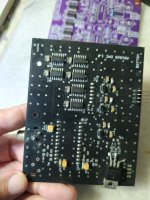
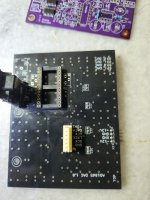
@rehanabidI have ordered one, since I am building my third TDA1541 DAC these days so instead of logic gates will give this module a try.
Another potential board to try in future would be Miro's i2s to PCM with reclock....
https://www.diyaudio.com/community/...s-input-nos-r-2r.354078/page-455#post-7755211
I am getting excited over this project , hopefully it will be a success by Miro.
Yes, the display is Chinese, as is the Amanero USB/I2S board, but I didn't notice any problems when changing the sampling rate. When I disconnect the LRCLK to the display, the sound does not change. I tried that right away, already with the previous display. If it showed some bad influence, I wouldn't put it. In principle, the display is $30 for a nicer device. And it is useful occasionally.Two observations I presume you are using the LRCLK sample rate display (chinese one) its greatest drawback I think is its frequent "hanging" and not refreshing the sample rate frequently.
Like very much the tidy build of @NIXIE62 , perhaps would ask him a link to the enclosure?
However, while waiting for ad1862 replacements, was does one?
An AD1865!!!!
Not bad, really not bad sound, quite natural and flat, I would say more "neutral" than his brother 1862, according to my ears... Nice bass... Same setup, tube output.
This enclosure was studied for the big brother, but like Achilles and the turtle, small brother arrived first 😁😁😁
The regulator you see down left is a tps7a series on AliExpress
To use the +/-15 supply of big brother.
Now my usual test playlist, ears well open, let's have a smash 😁🤩😍💩💩💩
However, while waiting for ad1862 replacements, was does one?
An AD1865!!!!
Not bad, really not bad sound, quite natural and flat, I would say more "neutral" than his brother 1862, according to my ears... Nice bass... Same setup, tube output.
This enclosure was studied for the big brother, but like Achilles and the turtle, small brother arrived first 😁😁😁
The regulator you see down left is a tps7a series on AliExpress
TPS7A4701 + TPS7A3301
https://a.aliexpress.com/_EIYt2KHTo use the +/-15 supply of big brother.
Now my usual test playlist, ears well open, let's have a smash 😁🤩😍💩💩💩
Attachments
When I look at the pictures, it is how I like a DAC in a definitive living room setup ! 🙂 😍
Don't change anything ! When cleaner, it is just about bourgeoisie ! 🤣
Don't change anything ! When cleaner, it is just about bourgeoisie ! 🤣
In my experience Bursons are best combo with AD1865, followed by OPA627.
Try the tube IV stage. The AD1865R very good with it.
An AD1865!!!!
Not bad, really not bad sound, quite natural and flat, I would say more "neutral" than his brother 1862, according to my ears... Nice bass... Same setup, tube output.
Glad you like it, I thought the tube stage brought out the music from the 1865, Dark IV sounded pretty good too. Excellent value DAC and so easy to power.
- Home
- Source & Line
- Digital Line Level
- DAC AD1862: Almost THT, I2S input, NOS, R-2R
